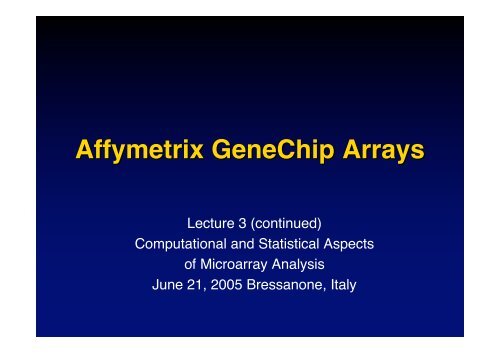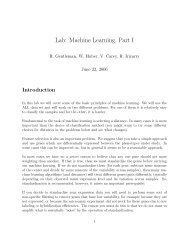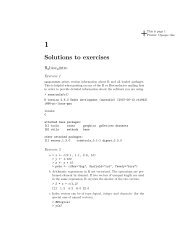Affymetrix GeneChip Arrays
Affymetrix GeneChip Arrays
Affymetrix GeneChip Arrays
Create successful ePaper yourself
Turn your PDF publications into a flip-book with our unique Google optimized e-Paper software.
<strong>Affymetrix</strong> <strong>GeneChip</strong> <strong>Arrays</strong><br />
Lecture 3 (continued)<br />
Computational and Statistical Aspects<br />
of Microarray Analysis<br />
June 21, 2005 Bressanone, Italy
<strong>Affymetrix</strong> <strong>GeneChip</strong> Design<br />
5’ 3’<br />
Reference sequence<br />
…TGTGATGGTGGGGAATGGGTCAGAAGGCCTCCGATGCGCCGATTGAGAAT…<br />
CCCTTACCCAGTCTTCCGGAGGCTA Perfectmatch<br />
CCCTTACCCAGTGTTCCGGAGGCTA Mismatch<br />
NSB & SB<br />
NSB
Terminology<br />
• Each gene or portion of a gene is represented by 1q to 20<br />
oligonucleotides of 25 base-pairs.<br />
• Probe: an oligonucleotide of 25 base-pairs, i.e., a 25-mer.<br />
• Perfect match (PM): A 25-mer complementary to a reference<br />
sequence of interest (e.g., part of a gene).<br />
• Mismatch (MM): same as PM but with a single homomeric base<br />
change for the middle (13 th ) base (transversion purine <br />
pyrimidine, G C, A T) .<br />
• Probe-pair: a (PM,MM) pair.<br />
• Probe-pair set: a collection of probe-pairs (1q to 20) related to a<br />
common gene or fraction of a gene.<br />
• Affy ID: an identifier for a probe-pair set.<br />
• The purpose of the MM probe design is to measure nonspecific<br />
binding and background noise.
<strong>Affymetrix</strong> files<br />
• Main software from <strong>Affymetrix</strong> company<br />
MicroArray Suite - MAS, now version 5.<br />
• DAT file: Image file, ~10^7 pixels, ~50 MB.<br />
• CEL file: Cell intensity file, probe level PM and<br />
MM values.<br />
• CDF file: Chip Description File. Describes<br />
which probes go in which probe sets and the<br />
location of probe-pair sets (genes, gene<br />
fragments, ESTs).
Expression Measures<br />
• 10-20K genes represented by 11-20<br />
pairs of probe intensities (PM & MM)<br />
• Obtain expression measure for each<br />
gene on each array by summarizing<br />
these pairs<br />
• Background adjustment and<br />
normalization are important issues<br />
• There are many methods
Data and notation<br />
• PM ijg , MM ijg = Intensity for perfect match and<br />
mismatch probe in cell j for gene g in chip i.<br />
– i = 1,…, n -- from one to hundreds of chips;<br />
– j = 1,…, J -- usually 11 or 20 probe pairs;<br />
– g = 1,…, G -- between 8,000 and 20,000 probe sets.<br />
• Task: summarize for each probe set the probe level<br />
data, i.e., PM and MM pairs, into a single expression<br />
measure.<br />
• Expression measures may then be compared within or<br />
between chips for detecting differential expression.
MAS 4.0<br />
• <strong>GeneChip</strong> ® MAS 4.0 software used AvDiff up<br />
until 2001<br />
1<br />
AvDiff = ∑(<br />
PM − MM )<br />
Α<br />
j j<br />
j∈Α<br />
where A is a set of “suitable” pairs, e.g., pairs with d j = PM j -MM j<br />
within 3 SDs of the average of d (2) , …, d (J-1)<br />
• Obvious problems:<br />
– Negative values<br />
– No log scale
Why use log?<br />
Original scale<br />
Original Scale<br />
Log scale<br />
Log Scale
Li and Wong’s s observations<br />
• There is a large probe effect<br />
• There are outliers that are only noticed<br />
when looking across arrays<br />
• Non- linear normalization needed<br />
(discussed in previous lecture)<br />
PNAS vol. 98. no. 1, 31-36
Probe effect
Probe effect makes correlation deceiving<br />
Correlation for absolute expression of replicates<br />
looks great! But…
Probe effect makes correlation deceiving<br />
•It is better to look at relative expression because<br />
probe effect is somewhat cancelled out.<br />
•Later we will see that we can take advantage of<br />
probe effect to find outlier probes.
Li & Wong<br />
• Li & Wong (2001) fit a model for each probe set, i.e.,<br />
gene<br />
PM<br />
ij<br />
− MM<br />
ij<br />
= θ φ<br />
i<br />
j<br />
+ ε<br />
N(0,<br />
σ<br />
where<br />
– θ i : model based expression index (MBEI),<br />
– φ j : probe sensitivity index.<br />
• Maximun likelihood estimate of MBEI is used as<br />
expression measure for the gene in chip i.<br />
• Non-linear normalization used<br />
• Ad-hoc procedure used to remove outliers<br />
• Need at least 10 or 20 chips<br />
ij<br />
,<br />
ε<br />
ij<br />
∝<br />
2<br />
)
There is one more reason why<br />
PM-MM is undesirable
Especially for large PM
We see bimodality<br />
log 2 PM-log 2 MM<br />
(log 2 PM+log 2 MM)/2
Two more problems with MM<br />
• MM detect signal<br />
• MM cost $$$
MAS 5.0<br />
• Current version, MAS 5.0, uses Signal<br />
signal<br />
*<br />
= Tukey Biweight{log( PM j<br />
− MM j<br />
)}<br />
• Notice now log is used<br />
• But what about negative PM-MM ?<br />
• MM* is a new version of MM that is never larger than PM.<br />
• If MM < PM, MM* = MM.<br />
• If MM >= PM,<br />
– SB = Tukey Biweight (log(PM)-log(MM))<br />
(log-ratio).<br />
– log(MM*) = log(PM)-log(max(SB, +ve)).<br />
• Tukey Biweight: B(x) = (1 – (x/c)^2)^2 if |x|
Can this be improved?<br />
Rank of<br />
Spikeins<br />
(out of<br />
12626)<br />
We will discuss P/M/A calls later<br />
141<br />
250<br />
364<br />
368<br />
480<br />
586<br />
686<br />
838<br />
945<br />
1153<br />
1567<br />
NA<br />
NA<br />
NA<br />
NA
MBEI not much better
RMA<br />
• Robust regression method to estimate expression measure and<br />
SE from PM * (background adjusted normalized PM)<br />
• Use quantile normalization<br />
• Assume additive model<br />
log (PM * ) = a + b + ε 2 ij i j ij<br />
• Estimate RMA = a i for chip i using robust method, such as<br />
median polish (fit iteratively, successively removing row and<br />
column medians, and accumulating the terms, until the process<br />
stabilizes).<br />
• Works with n=2 or more chips<br />
•<br />
€<br />
This is a robust multi-array analysis (RMA)
Can this be improved?<br />
Rank of<br />
Spikeins<br />
(out of<br />
12626)<br />
141<br />
250<br />
364<br />
368<br />
480<br />
586<br />
686<br />
838<br />
945<br />
1153<br />
1567<br />
NA<br />
NA<br />
NA<br />
NA
RMA<br />
Rank of<br />
Spikeins<br />
(out of<br />
12626)<br />
Irizarry et al. (2003) NAR 31:e15<br />
1<br />
2<br />
3<br />
4<br />
7<br />
11<br />
15<br />
21<br />
35<br />
122<br />
1182<br />
230<br />
450<br />
1380<br />
11700
QC from probe level models<br />
• RMA fits a probe level model<br />
• From these fits we can obtain residuals<br />
• We can also get weights if we use formal robust regression<br />
procedures instead of median polish<br />
• These probe-level residuals and summaries of their size can be<br />
used for quality control<br />
• Software available: affyPLM Bioconductor package (Ben<br />
Bolstad)
Images of probe level data<br />
This is the raw data
Images of probe level data<br />
Log scale version much more informative
Images of probe level data<br />
Residuals (or weights) from probe level<br />
model fits show problem clearly
Images of probe level data<br />
Here is a more subtle artifact. Can you see it?<br />
The strong probe effect does not let you.
Images of probe level data<br />
Probe level fit residuals really show it
Other pseudo-chip images<br />
Weights<br />
Residuals<br />
Positive<br />
Residuals<br />
Negative<br />
Residuals
NUSE<br />
Normalized<br />
Unscaled<br />
Standard<br />
Errors
Can RMA be improved?<br />
RMA attenuates<br />
signal slightly to<br />
achieve gains in<br />
precision<br />
method<br />
MAS 5.0<br />
RMA<br />
slope<br />
0.69<br />
0.61<br />
More on this later (if time permits)
Detection
Detection<br />
• The detection problem:<br />
“Given the probe-level data, which mRNA<br />
transcripts are present in the sample?”<br />
• Biologists are mostly interested in expression<br />
levels, and so detection has received less<br />
attention<br />
• To date only <strong>Affymetrix</strong> has tackled this, with<br />
– Rank-based tests<br />
– Implemented in MAS5.0
MAS Rank-based Detection<br />
The test used in MAS 5.0 compares the following two hypotheses<br />
H 0 : median (PM j - MM j )/(PM j + MM j ) = τ ;<br />
H 1 : median (PM j - MM j )/(PM j + MM j ) > τ.<br />
Significance levels: 0 < α 1 < α 2 < 0.5. If p is the p-value for the (rank)<br />
test, MAS 5.0 calls a transcript<br />
absent: if p > α 2 ,<br />
marginal: if α 1 ≤ p ≤ α 2 , and<br />
present: if p < α 1 .<br />
Typically tests are carried out with τ = 0.15, α 1 = .04 and α 2 = .06.
Expression Detection<br />
MAS 5.0
Remember uncertainty<br />
• Some data analysts remove probesets<br />
called absent from further analysis<br />
• This creates false negatives:<br />
HG95<br />
P<br />
M<br />
A<br />
Present<br />
82%<br />
1%<br />
17%<br />
Absent<br />
0%<br />
0%<br />
100%<br />
HGU133<br />
P<br />
M<br />
A<br />
Present<br />
77%<br />
3%<br />
20%<br />
Absent<br />
0%<br />
0%<br />
100%<br />
From spike-in experiments
Consistency across reps
Consistency across reps
Current work<br />
• We need better estimates of means and<br />
variances of bivariate normal<br />
background noise<br />
• Use observed MM intensities along with<br />
sequence information<br />
• We also have a solution that does not<br />
use the MM
Predict NSB with sequence<br />
• Fit simple linear<br />
model to yeast on<br />
human data to obtain<br />
base/position effects
Predict NSB with sequence<br />
• Fit simple linear<br />
model to yeast on<br />
human data to obtain<br />
base/position effects<br />
• Call these affinities<br />
and use them to<br />
obtain parameters<br />
for background<br />
model
Also explains MM thing
Also explains MM thing
Does it help?<br />
• We can predict<br />
empirical results<br />
with model<br />
• Accuracy of<br />
expression<br />
measures<br />
improves…
Does it help?<br />
• We can predict empirical<br />
results with model<br />
• Accuracy of expression<br />
measures improves…<br />
• Without adding too<br />
much variance
Alternative background adjustment<br />
• Use this stochastic model<br />
• Minimize the MSE:<br />
• To do this we need to specify distributions for the different<br />
€<br />
components<br />
• Notice this is probe-specific so we need to borrow strength<br />
€<br />
⎡ ⎧ ⎛ s<br />
E log⎜ ˜ ⎞ ⎫<br />
⎢ ⎨ ⎟ ⎬<br />
⎣ ⎢ ⎩ ⎝ s⎠<br />
⎭<br />
2<br />
⎤<br />
S > 0,PM, MM⎥<br />
⎦ ⎥<br />
* These parametric distributions were chosen to provide a closed form solution








